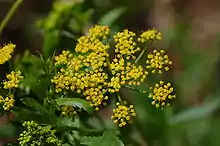Zizia aurea
Zizia aurea (golden alexanders, golden zizia) is a flowering perennial forb of the carrot family (Apiaceae). Golden alexanders is native to eastern Canada and the United States, from the eastern Great Plains to the Atlantic Coast. Named for Johann Baptist Ziz. a German botanist.[2]
| Zizia aurea | |
|---|---|
 | |
| Scientific classification | |
| Kingdom: | Plantae |
| Clade: | Tracheophytes |
| Clade: | Angiosperms |
| Clade: | Eudicots |
| Clade: | Asterids |
| Order: | Apiales |
| Family: | Apiaceae |
| Genus: | Zizia |
| Species: | Z. aurea |
| Binomial name | |
| Zizia aurea | |
| Synonyms[1] | |
| |
Description

Zizia aurea ranges in height from 40 to 75 centimetres (16 to 30 in) tall but can sometimes grow taller. The leaves can grow up to 8 cm (3 1⁄4 in) long and 5 cm (2 in) wide.The leaves are attached to the stems alternately. Each leaf is compound and odd-pinnate, with leaflets that are normally lanceolate or ovate and have serrated edges.[3]
It blooms from May to June. Its flowers are yellow and grow in a flat-topped umbel at the top of the plant. Each flower is only 3 mm (0.12 in) long and has five sepals, five petals, and five stamens. Each flower produces a single 3 to 4 mm (0.12 to 0.16 in) long, oblong fruit (schizocarp) containing two seeds. In the fall both the leaves and the fruit turn purple.[3]
Distribution and habitat
Golden Alexander is native to the United States and Canada. It grows from New Brunswick to Saskatchewan, south to Florida and Texas, and west to Montana.[4] It is found in a broad variety of habitats, such as moist black soil prairies, openings in moist to mesic woodlands, savannas, thickets, limestone glades and bluffs, power line clearings in woodland areas, abandoned fields, and wet meadows.[3][5] It can dry summers even though it prefers wet habitats.[3] It is hardy in USDA zones 4–9.
Ecology
It is a host plant for the caterpillars of the black swallowtail (Papilio polyxenes asterius) and Ozark swallowtail (Papilio joanae) butterflies.[3] Females of the mining bee species Andrena ziziae are oligolectic on Zizia aurea—they eat only its pollen.[5] Dozens of species of bees, flies, wasps, butterflies, and other insects visit the flowers of Zizia aurea for its nectar.[5]
References
- "Zizia aurea". Tropicos. Missouri Botanical Gardens – via The Plant List.
- Zizia aurea (L.) W.D.J.Koch Wisconsin State Herbarium, UW-Madison
- Hilty, John (2016). "Golden Alexanders (Zizia aurea)". Illinois Wildflowers.
- USDA NRCS Plant Fact Sheet for Z. aurea Retrieved 2010-03-08
- Wilhelm, Gerould; Rericha, Laura (2017). Flora of the Chicago Region: A Floristic and Ecological Synthesis. Indiana Academy of Sciences.